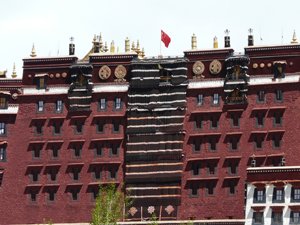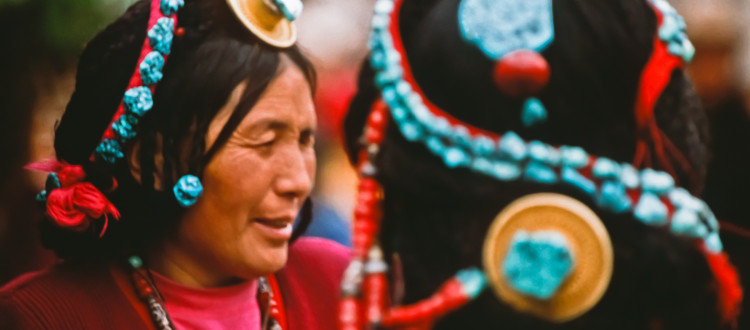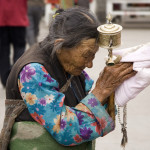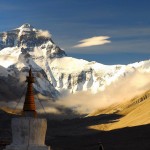Potala
High on Moburi (‘Red Hill’), in central Lhasa, stands the world famous Potala Palace. It was built as the center of Tibetan government by the fifth Dalai Lama in 1645.
This amazing palace has the honor of being the highest ancient palace in the world, with its highest point reaching 3,750 meters (12,300 feet) above sea level, towering 100 meters (300 feet) above the city of Lhasa. This 13-stories-high palace has over 1,000 rooms, and covers over 13 hectares (32 acres). The stone walls measure 3 meters (10 feet) thick on average.
- Chinese:布达拉宫 Bùdálā Gōng /boo-daa-laa gong/
- Location:central Lhasa, 2 km north of the Lhasa river, 5 km south of Sera Monastery, 3 km east of Norbulingka, and 2 km west of Jokhang Temple
- Altitude:3,750 m (12,300 ft)
- Built: from 1645
- Tour time:1 hour in the peak season; 2 hours in the low season
World Wonder and Pilgrimage Site
The Potala Palace has stood for centuries as a testament to the Tibetan people and their beliefs. Thousands of pilgrims from around the world come every year to pay homage to this grand estate and the symbol it stands for.
Considered to be one of the wonders of the world for its physical structure and its importance in Tibetan history, the Potala Palace is admired by all who visit.
Symbolize the height of technology and civilization during those periods!
Highlights
The general structure of the Potala Palace is in two parts: the Red Palace and the White Palace. The beautiful murals inside the palace are not only attractive, but also tell the story of Tibet. The golden roof group on the top of the Red Palace is worth seeing.
The Red Palace

The Red Palace is the higher of the two palaces, and is made up of several chapels. Used as a house of prayer by the Dalai Lama, this part of the Potala Palace was dedicated to the study of Buddhism and the advancement of the religion.
Housed within the Red Palace are several mausoleums of previous Dalai Lamas. Each mausoleum is built with stateliness and honor in mind. The mausoleum of the fifth Dalai Lama (the Potala’s patron), located in the west of the palace stands five stories high, is overlaid with gold, diamonds, pearls, and many other precious gems, and expresses the high honor the people had for this Buddhist saint.
The White Palace
The White Palacewas home to ten successive Dalai Lamas and their courts. Also located there are the offices of the Tibetan government, governmental assembly halls, and other official offices.
 The White Palace
The White PalaceThe original White Palace was built as a present from King Songtsan Gampo to his bride-to-be in 637, but destroyed during the ninth century. The fifth Dalai Lama built the current one on its site, and therefore, this structure pays homage to him in greater measure than previous Dalai Lamas or those that would follow.
After Norbulingka was built in 1755, it became the summer residence of the Dalai Lama, and the White Palace became known as the winter estate of this saint of Buddhism.
Inside the Potala Palace
Housed within this amazing stone and wood structure are articles and artifacts from Tibetan history, religion, and culture. Statues of Buddha, murals, and antiques that are centuries old, and incredible works of art grace every area of this mountaintop palace.
The elaborate works of art and murals tell many stories of the Dalai Lamas and the history of the Tibetan people, and depict different customs and traditions held dear in this beautiful part of the world.
One area of particular importance is the wall frescoes that depict the life and works of the fifth Dalai Lama. Other precious works of art include ornate statues, sculptures, and Tibetan paintings.
Of all the ornate decorations located within these sacred walls, visitors should take time to visit the topmost hall. Called Sasong Langjie, this hall was built in 1679 and contains a portrait of the Qing Emperor Qianlong. An inscription on this portrait “A long, long life to the present emperor” is written in the languages of Han, Manchu, Mongol, and Tibetan. It is here that Dalai Lamas have come to pay homage every Tibetan New Year’s Day for centuries as they pray for guidance and direction for the Tibetan people.
The Golden Roof Group

The golden roof group is a unique view of the Potala Palace. It’s on the top of the Red Palace, composed of seven roofs made of gilded bronze. They are the tops of the holy stupas of the Dalai Lamas. Every golden roof is decorated with one to five flower-and-bell-shaped spires, which serve as lightning conductors. If you step out on the palace roof, you can see the blue sky and white cloud above your head and overlook the city.
Best Photo Sites
To see the Potala Palace from afar is the best way to appreciate the panorama of this spectacular building. The roof of Jokhang Temple (east of the palace) and Chakpori (southwest of the palace) are the best sites. Our guides know the best places to take beautiful photos.
Credit and Source: http://www.chinahighlights.com/lhasa/ttraction/potala-palace.htm









